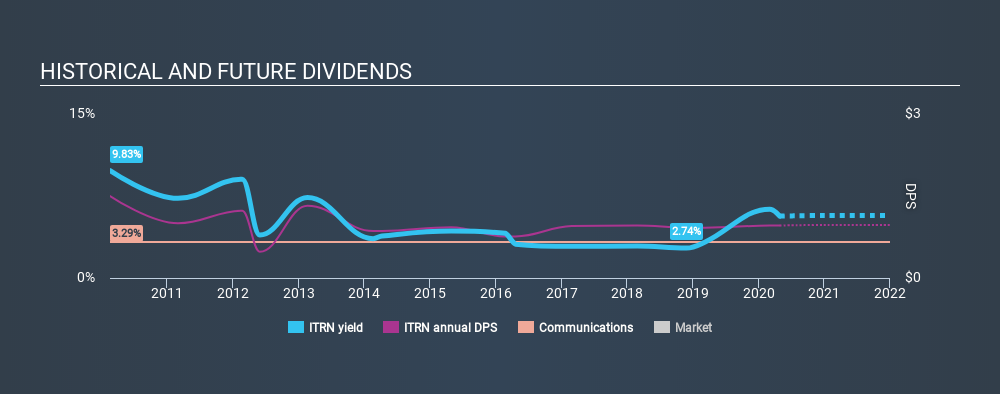Stock Analysis
- United States
- /
- Communications
- /
- NasdaqGS:ITRN
Do Investors Have Good Reason To Be Wary Of Ituran Location and Control Ltd.'s (NASDAQ:ITRN) 5.7% Dividend Yield?

Could Ituran Location and Control Ltd. (NASDAQ:ITRN) be an attractive dividend share to own for the long haul? Investors are often drawn to strong companies with the idea of reinvesting the dividends. If you are hoping to live on the income from dividends, it's important to be a lot more stringent with your investments than the average punter.
A high yield and a long history of paying dividends is an appealing combination for Ituran Location and Control. We'd guess that plenty of investors have purchased it for the income. During the year, the company also conducted a buyback equivalent to around 1.7% of its market capitalisation. Remember that the recent share price drop will make Ituran Location and Control's yield look higher, even though recent events might have impacted the company's prospects. Some simple analysis can offer a lot of insights when buying a company for its dividend, and we'll go through this below.
Explore this interactive chart for our latest analysis on Ituran Location and Control!

Payout ratios
Dividends are typically paid from company earnings. If a company pays more in dividends than it earned, then the dividend might become unsustainable - hardly an ideal situation. So we need to form a view on if a company's dividend is sustainable, relative to its net profit after tax. Looking at the data, we can see that 293% of Ituran Location and Control's profits were paid out as dividends in the last 12 months. A payout ratio above 100% is definitely an item of concern, unless there are some other circumstances that would justify it.
Another important check we do is to see if the free cash flow generated is sufficient to pay the dividend. Ituran Location and Control's cash payout ratio in the last year was 48%, which suggests dividends were well covered by cash generated by the business. It's disappointing to see that the dividend was not covered by profits, but cash is more important from a dividend sustainability perspective, and Ituran Location and Control fortunately did generate enough cash to fund its dividend. Still, if the company repeatedly paid a dividend greater than its profits, we'd be concerned. Extraordinarily few companies are capable of persistently paying a dividend that is greater than their profits.
Is Ituran Location and Control's Balance Sheet Risky?
As Ituran Location and Control's dividend was not well covered by earnings, we need to check its balance sheet for signs of financial distress. A rough way to check this is with these two simple ratios: a) net debt divided by EBITDA (earnings before interest, tax, depreciation and amortisation), and b) net interest cover. Net debt to EBITDA measures total debt load relative to company earnings (lower = less debt), while net interest cover measures the ability to pay interest on the debt (higher = greater ability to pay interest costs). Ituran Location and Control has net debt of 0.19 times its EBITDA, which we think is not too troublesome.
Net interest cover can be calculated by dividing earnings before interest and tax (EBIT) by the company's net interest expense. With EBIT of 23.13 times its interest expense, Ituran Location and Control's interest cover is quite strong - more than enough to cover the interest expense.
Consider getting our latest analysis on Ituran Location and Control's financial position here.
Dividend Volatility
From the perspective of an income investor who wants to earn dividends for many years, there is not much point buying a stock if its dividend is regularly cut or is not reliable. For the purpose of this article, we only scrutinise the last decade of Ituran Location and Control's dividend payments. Its dividend payments have declined on at least one occasion over the past ten years. During the past ten-year period, the first annual payment was US$1.50 in 2010, compared to US$0.96 last year. The dividend has shrunk at around 4.4% a year during that period. Ituran Location and Control's dividend hasn't shrunk linearly at 4.4% per annum, but the CAGR is a useful estimate of the historical rate of change.
We struggle to make a case for buying Ituran Location and Control for its dividend, given that payments have shrunk over the past ten years.
Dividend Growth Potential
With a relatively unstable dividend, it's even more important to see if earnings per share (EPS) are growing. Why take the risk of a dividend getting cut, unless there's a good chance of bigger dividends in future? Over the past five years, it looks as though Ituran Location and Control's EPS have declined at around 26% a year. A sharp decline in earnings per share is not great from from a dividend perspective, as even conservative payout ratios can come under pressure if earnings fall far enough.
Conclusion
To summarise, shareholders should always check that Ituran Location and Control's dividends are affordable, that its dividend payments are relatively stable, and that it has decent prospects for growing its earnings and dividend. We're not keen on the fact that Ituran Location and Control paid out such a high percentage of its income, although its cashflow is in better shape. Second, earnings per share have been in decline, and its dividend has been cut at least once in the past. With this information in mind, we think Ituran Location and Control may not be an ideal dividend stock.
It's important to note that companies having a consistent dividend policy will generate greater investor confidence than those having an erratic one. Meanwhile, despite the importance of dividend payments, they are not the only factors our readers should know when assessing a company. For example, we've picked out 5 warning signs for Ituran Location and Control that investors should know about before committing capital to this stock.
Looking for more high-yielding dividend ideas? Try our curated list of dividend stocks with a yield above 3%.
If you spot an error that warrants correction, please contact the editor at editorial-team@simplywallst.com. This article by Simply Wall St is general in nature. It does not constitute a recommendation to buy or sell any stock, and does not take account of your objectives, or your financial situation. Simply Wall St has no position in the stocks mentioned.
We aim to bring you long-term focused research analysis driven by fundamental data. Note that our analysis may not factor in the latest price-sensitive company announcements or qualitative material. Thank you for reading.
About NasdaqGS:ITRN
Ituran Location and Control
Provides location based telematics services and machine-to-machine telematics products.
Outstanding track record with flawless balance sheet and pays a dividend.

